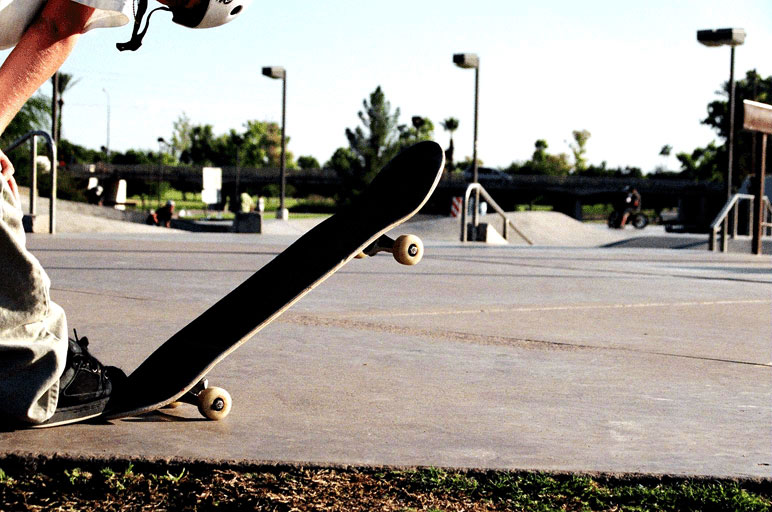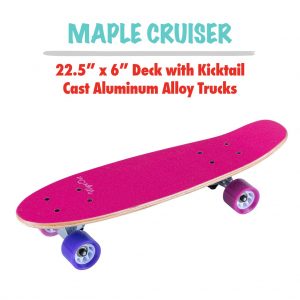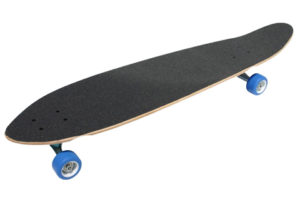Skateboarding has evolved from a niche hobby to a popular sport and mode of transportation. With various styles and types of skateboards available, traditional skateboards, penny boards, and longboards have gained significant popularity among riders of all ages and skill levels. Each type of skateboard has its unique characteristics, offering different riding experiences and advantages. Let’s compare traditional skateboards, penny boards, and longboards to help you understand the key differences between them.
Traditional Street Skateboards
 Traditional skateboards are the most common type of skateboard and are typically made of a wooden deck with grip tape on top, trucks underneath, and urethane wheels. They come in various shapes, sizes, and designs, offering versatility for different styles of riding, including street skating, park skating, and vert skating. Traditional skateboards are known for their maneuverability and are ideal for performing tricks, flips, and grinds.
Traditional skateboards are the most common type of skateboard and are typically made of a wooden deck with grip tape on top, trucks underneath, and urethane wheels. They come in various shapes, sizes, and designs, offering versatility for different styles of riding, including street skating, park skating, and vert skating. Traditional skateboards are known for their maneuverability and are ideal for performing tricks, flips, and grinds.
Penny Boards
 Penny boards, on the other hand, are smaller, plastic skateboards that have gained popularity for their portability and unique design. They typically have a compact deck with a length ranging from 22 to 27 inches, making them lightweight and easy to carry around. Penny boards are known for their smooth and quick ride, making them suitable for cruising and commuting in urban environments. They are also popular among beginners due to their stability and ease of use.
Penny boards, on the other hand, are smaller, plastic skateboards that have gained popularity for their portability and unique design. They typically have a compact deck with a length ranging from 22 to 27 inches, making them lightweight and easy to carry around. Penny boards are known for their smooth and quick ride, making them suitable for cruising and commuting in urban environments. They are also popular among beginners due to their stability and ease of use.
Longboards
Longboards, as the name suggests, are longer and wider boards that are designed for cruising and downhill riding. They typically have a deck length ranging from 36 to 60 inches, offering more stability and comfort compared to traditional skateboards and penny boards. Longboards are known for their smooth and fast rides, making them ideal for transportation and downhill racing. They often feature softer wheels and trucks that provide a more stable and smooth ride, making them suitable for longer distances and higher speeds.
length ranging from 36 to 60 inches, offering more stability and comfort compared to traditional skateboards and penny boards. Longboards are known for their smooth and fast rides, making them ideal for transportation and downhill racing. They often feature softer wheels and trucks that provide a more stable and smooth ride, making them suitable for longer distances and higher speeds.
Comparing Longboards, Skateboards, and Penny Boards
Uses of Each
One of the main differences between traditional skateboards, penny boards, and longboards is their riding style and purpose. Traditional skateboards are primarily used for performing tricks and technical maneuvers in skate parks or on the streets. Penny boards, on the other hand, are designed for cruising and commuting, offering a quick and easy way to get around urban environments. Longboards are designed for cruising, downhill racing, and transportation, providing a comfortable and stable ride for longer distances.
Size and Weight
Another key difference is the size and weight of the boards. Traditional skateboards are generally smaller and lighter, offering more maneuverability for performing tricks. Penny boards are compact and lightweight, making them highly portable and suitable for riders who need to carry their board around frequently. Longboards, on the other hand, are longer and heavier, providing stability and comfort for longer rides.
Construction
The wheels and trucks also differ among the three types of skateboards. Traditional skateboards usually have harder wheels and tighter trucks, providing more control and responsiveness for performing tricks. Penny boards typically have softer wheels and looser trucks, offering a smoother and more comfortable ride on rough surfaces. Longboards often have larger and softer wheels, providing a smoother ride and better grip for downhill riding and cruising on uneven terrain. For a complete list of the construction components of a skateboard, look here: https://skateboardforkids.com/anatomy-of-the-skateboard-and-understanding-what-youre-buying-for-your-child/
Skill Requirements
In terms of skill level, traditional skateboards require more technical skills for performing tricks and maneuvers, making them suitable for experienced riders. Penny boards are generally beginner-friendly, offering stability and ease of use for riders who are new to skateboarding. Longboards are suitable for riders of all skill levels, from beginners to experienced riders, due to their stability and versatility for different types of riding.
Traditional skateboards, penny boards, and longboards have their unique characteristics and advantages. Street skateboards are ideal for performing tricks and technical maneuvers, penny boards are suitable for cruising and commuting in urban environments, and longboards are designed for cruising, downhill racing, and transportation. Consider your riding style, purpose, skill level, and preferences to choose the type of skateboard that best suits your needs.
Which is Best for Beginners?
For beginners, penny boards are often considered a great option due to their stability, ease of use, and portability. They provide a smooth and comfortable ride, making it easier for beginners to learn the basics of skateboarding without much difficulty. Penny boards also have softer wheels and looser trucks, which offer a more forgiving ride for those who are new to skateboarding and may need more stability. One of the downsides is that the skills developed on penny boards may not exactly translate to a street skateboard when a young skateboarder decides to move on to the more challenging style.
Longboards are also a good option for beginners due to their stability and comfort. They provide a smooth and comfortable ride, making them suitable for riders who are still building their balance and coordination skills. Longboards are also great for cruising and transportation, which can be appealing to beginners who are looking for a skateboard that is versatile and practical for getting around.
While traditional skateboards can be more challenging for beginners due to their smaller size and tighter trucks, they can still be a viable option for those who are interested in learning tricks and technical maneuvers. With practice and determination, beginners can progress their skills on a traditional skateboard and eventually become proficient in performing tricks and maneuvers. At Skateboardforkids.com, we’ve seen hundreds of young skateboarders as earlier as 4 or 5 years old thrive using our beginner skateboard.
Ultimately, the best option for beginners depends on personal preferences, riding style, and intended use. Penny boards and longboards are generally considered more beginner-friendly due to their stability, comfort, and ease of use. However, with determination and practice, beginners can also excel on traditional skateboards. It’s important to choose a skateboard that matches your skill level and riding goals, and always practice proper safety measures, such as wearing a helmet and other protective gear, regardless of the type of skateboard you choose.
In conclusion, when comparing traditional skateboards, penny boards, and longboards, it’s important to consider factors such as riding style, purpose, skill level, and preferences. Each type of skateboard has its unique characteristics and advantages, making them suitable for different riders with different needs. For beginners, penny boards and longboards are often considered good options due to their stability and ease of use. However, with practice and determination, beginners can also excel on traditional skateboards. Choose a skateboard that aligns with your riding goals and always prioritize safety when skateboarding. All of our skateboardforkids..com organic equipment, helmets, pads, and boards are MADE IN THE USA! Happy riding!









